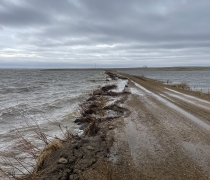Visit Us
To preserve the area's natural beauty and character of Chase Lake National Wildlife Refuge, all but 230 acres of the 4,385 acres are designated as Wilderness Area. As Wilderness Area, access to this Refuge is limited but visitors to the area can view the vast expanse of rolling hills across the Refuge. scan for nesting pelicans or watch adult pelicans as they fly to and from the Refuge to feed in nearby wetlands from adjacent county and township roads. Area roads are either gravel or prairie trails that may not be passable by during adverse weather conditions. Some areas of the Refuge are open wildlife viewing, photography, hiking, and hunting.
Location and Contact Information
About Us
Chase Lake National Wildlife Refuge is one of two National Wildlife Refuges in North Dakota with designated Wilderness Areas. The 4,385-acre Refuge is evenly split between water and grassland habitats. The Refuge lies on the Missouri Coteau, a geographic area with sharp rolling hills and thousands of various-sized wetlands. The grassland areas are a mix of short and mid-grass prairie, dominated by blue grama, green needlegrass, and many wildflowers.
What We Do
The Refuge is managed for migratory bird nesting habitat. Since the late 1990s, many other colonial nesting birds - egrets, herons, and gulls - have taken up nesting at Chase Lake alongside the pelicans. Refuge staff focus on maintaining and restoring the biological integrity, diversity, environmental health, and wilderness character of the Refuge. This is accomplished via a strong understanding of fire, drought, flooding, storms, pest and disease outbreaks, and predator/prey relationships.
Our Species
The Refuge benefits more than just the American white pelican. Chase Lake National Wildlife Refuge provides nesting habitat for cattle egrets, snowy egrets, great egrets, double-crested cormorants, black-crowned night herons, little blue herons, white-faced ibis, glossy ibis, California gulls, and ring-billed gulls, making this a significant location for waterbird colonies in the northern plains.

